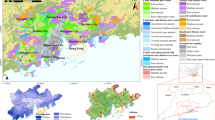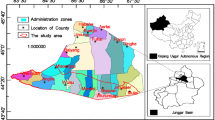Abstract
As a useful index-based evaluation framework, groundwater functional zoning (GWFZ) presents a very positive effect on groundwater management at a regional scale due to its concise results. Currently, the GWFZ lacks definition and detailed processes, hence requiring a systematic structure to offer more knowledge bases to the methodology. A typical study area (Weifang City) characterized by a coastal zone and relying on groundwater supply, as well as the occurrence of groundwater-derived geo-environmental issues, was chosen. We provided a detailed index-based GWFZ method by focusing on the assessment of the resource supply function (RSF) and geo-environment stability function (GSF), with a good understanding of the hydrogeological conditions in the selected area. The RSF was assessed by delineating the potential area of groundwater exploitation, while the GSF was evaluated by identifying the vulnerability of geo-environmental issues. By integrating the RSF and GSF into the GIS environment, the study area was finally divided into five functional sub-areas: concentrated groundwater supply area (1.08%), decentralized groundwater supply area (18.36%), vulnerable geo-environment area (11.78%), unsuitable to exploit groundwater area (14.11%), and recharge protection area (54.67%). Seven groundwater exploitation boreholes in the plain area were validated to be unreasonable with regard to mining scale, which indicates a connection with the inland saltwater intrusion boundary in recent years. With simple data acquisition methods and concise results, GWFZ is of great benefit to groundwater management and can be further applied in other regional studies.



(modified by Han et al. 2011)










Similar content being viewed by others
References
Adiat KAN, Nawawi MNM, Abdullah K (2012) Assessing the accuracy of GIS-based elementary multi criteria decision analysis as a spatial prediction tool—a case of predicting potential zones of sustainable groundwater resources. J Hydrol 440–441:75–89
Allouche N, Maanan M, Gontara M (2017) A global risk approach to assessing groundwater vulnerability. Environ Modell Softw 88:168–182
Baghapour MA, Nobandegani AF, Talebbeydokhti N (2016) Optimization of DRASTIC method by artificial neural network, nitrate vulnerability index, and composite DRASTIC models to assess groundwater vulnerability for unconfined aquifer of Shiraz Plain, Iran. J Environ Health Sci Eng 14:13
Bi QX (2006) Evaluation and study on water environment quality of Weifang City. Hohai University, Nanjing (in Chinese)
Bouderbala A, Remini B, Saaed Hamoudi A, Pulido-Bosch A (2016) Assessment of groundwater vulnerability and quality in coastal aquifers: a case study (Tipaza, North Algeria). Arab J Geosci 9:1–12
CGSB (2017) hydrogeological and geological database. China Geological Survey Bureau. http://geodata.ngac.cn/. Accessed Jan 2017
Chachadi AG (2005) Seawater intrusion mapping using modified GALDIT indicator model - case study in Goa. Jalvigyan Sameeksha 20:29–45
Chen HH, Zhang YX, Wang XM, Ren ZY, Li L (1997) Salt-water intrusion in the lower reaches of the Weihe River, Shandong Province, China. Hydrogeol J 5(3):82–88
Dong DL, Sun WJ, Zhu ZC, Xi S, Lin G (2013) Groundwater risk assessment of the third aquifer in Tianjin City, China. Water Resour Manag 27(8):3179–3190
Gao SD (2005) The estimation of the groundwater resources in Weifang City. Hohai University, Nanjing (in Chinese)
Grogij AD, Moghaddam AA (2016) Vulnerability Assessment of saltwater intrusion using simplified GAPDIT method: a case study of Azarshahr Plain Aquifer, East Azerbaijan, Iran. Arab J Geosci 9:106
Guan QH, Chen XQ, Zhang J (2014) Analysis on dynamic changes of salt water intrusion in Northern Weibei Plain in South Laizhou Bay. Shandong Land Resour 9:39–42 (in Chinese)
Han DM, Kohfahl C, Song XF, Xiao GQ (2011) Geochemical and isotopic evidence for palaeo-seawater intrusion into the south coast aquifer of Laizhou Bay, China. Appl Geochem 26:863–883
Han DM, Song XF, Currell MJ, Yang JL (2014) Chemical and isotopic constraints on evolution of groundwater salinization in the coastal plain aquifer of Laizhou Bay, China. J Hydrol 508:12–27
Hu YZ, Li H, Li Y, Shi PX (2015) Hydrogeochemical recognition of seawater intrusion process at the typical profile in Laizhou Bay. Geol Survey Res 1:41–50 (in Chinese)
Hu XM, Ma CM, Deng B (2017) Risk evaluation of land subsidence in coastal areas of Jiangsu Province. Geol Sci Technol Inf 36(2):222–228 (in Chinese)
Jothibasu A, Anbazhagan S (2018) Hydrogeological assessment of the groundwater aquifers for sustainability state and development planning. Environ Earth Sci 77:88
Kazakis N, Spiliotis M, Voudouris K, Pliakas FK (2018) A fuzzy multicriteria categorization of the GALDIT method to assess seawater intrusion vulnerability of coastal aquifers. Sci Total Environ 621:524–534
Kumar DM, Shah T (2006) Groundwater pollution and contamination in India: the emerging challenge. IWMI-TATA Water Policy Progr Draft Pap 1:14
Kumar T, Gautam AK, Kumar T (2014) Appraising the accuracy of GIS-based multi-criteria decision making technique for delineation of Groundwater potential zones. Water Resour Manag 28(13):4449–4466
Li PY, Wu JH (2010) Groundwater environmental problems and their countermeasures. Environ Sci Manag 35(4):60–62 (in Chinese)
Luoma S, Okkonen J, Korkka-Niemi K (2017) Comparison of the AVI, modified SINTACS and GALDIT vulnerability methods under future climate-change scenarios for a shallow low-lying coastal aquifer in southern Finland. Hydrogeol J 25(1):203–222
Mahrez B, Klebingat S, Begacem Houha (2018) GIS-based GALDIT method for vulnerability assessment to seawater intrusion of the Quaternary coastal Collo aquifer (NE-Algeria). Arab J Geosci 11:71
MLR (1994) Groundwater quality standards (GB/T 14848-93). Ministry of Land and Resources, Beijing (in Chinese)
Mogaji KA, Lim HS (2018) Development of groundwater favourability map using GIS-based driven data mining models: an approach for effective groundwater resource management. Geocarto Int 33(4):397–422
Motevalli A, Moradi HR, Javadi S (2018) A Comprehensive evaluation of groundwater vulnerability to saltwater up-coning and sea water intrusion in a coastal aquifer (case study: Ghaemshahr-juybar aquifer). J Hydrol 557:753–773
MWR (2005) Groundwater functional zoning outline. Ministry of Water Resources, Beijing (in Chinese)
Pedreira R, Kallioras A, Pliakas F (2015) Groundwater vulnerability assessment of a coastal aquifer system at River Nestos eastern Delta, Greece. Environ Earth Sci 73(10):6387–6415
Recinos N, Kallioras A, Pliakas F (2015) Application of GALDIT index to assess the intrinsic vulnerability to seawater intrusion of coastal granular aquifers. Environ Earth Sci 73:1017–1032
SDHB (2013) Report on the evaluation of groundwater overexploitation area in Shandong Province. Shandong Hydrological Bureau, Jinan (in Chinese)
SDSB (2018) Statistical yearbook of Shandong Province, Shandong Statistics Bureau. http://www.stats-sd.gov.cn/col/col6279/index.html. (in Chinese)
Singh LK, Jha MK, Chowdary VM (2018) Assessing the accuracy of GIS-based multi-criteria decision analysis approaches for mapping groundwater potential. Ecol Indic 91:24–37
Sun QY, Yu XX, Hu SP (2008) Extraction and application of hydrological information based on DEM in ArcGIS environment. J Beijing For Univ 30:144–147 (in Chinese)
Wang YY, Sun Q, Tan RJ (2009) Land subsidence in coastal areas based on geological factors. Chinese J Geol Hazard Control 4:86–94 (in Chinese)
Wang JJ, He JT, Chen HH (2012) Assessment of groundwater contamination risk using hazard quantification, a modified DRASTIC model and groundwater value, Beijing Plain, China. Sci Total Environ 432:216–226
Wu XY, Li B, Ma CM (2018) Assessment of groundwater vulnerability by applying the modified DRASTIC model in Beihai City, China. Environ Sci Pollut R 25:12713–12727
Xue YQ, Wu JC, Xie CH, Zhang YX (1997) Study on intrusion of sea and salt water along Laizhou Bay. Chin Sci Bull 22:2360–2368 (in Chinese)
Xue YQ, Wu JC, Ye SJ, Zhang YX (2000) Hydrogeological and hydrogeochemical studies for salt water intrusion on the south coast of Laizhou Bay, China. Groundwater 38(1):38–45
Yang JX (1991) Distribution patterns of soft soil layers and the classification of engineering geology layers in Tianjin plain. J Tianjin Univ S2:126–131 (in Chinese)
Yang Y, Zheng FD, Liu LC (2013) Susceptibility zoning and control measures on land subsidence caused by groundwater exploitation. Geol China 40(2):653–658 (in Chinese)
Zhang RQ, Liang X, Jin MG (2011) Fundamentals of hydrogeology. Geological Press, Beijing (in Chinese)
Zhang YW, Li HX, Shang TT (2016) Application of extenincs theory for partition of land subsidence susceptible area of Dezhou City based on analytic hierarchy process. Shandong Land Resour 32(7):58–64 (in Chinese)
Zhang X, Miao J, Hu BX (2017) Hydrogeochemical characterization and groundwater quality assessment in intruded coastal brine aquifers (Laizhou Bay, China). Environ Sci Pollut Res 24:21073–21090
Zheng YM, Gao MS, Liu S, Wang ST (2014) Distribution characteristics of subsurface brine resources on the southern coast of Laizhou bay since late Pleistocene. Hydrogeol Eng Geol 41(5):11–18 (in Chinese)
Acknowledgements
Funding for this project are supported by National Natural Science Foundation of China (No. 41572212) and Fundamental Research Funds for the Central Universities, China University of Geoscience, Wuhan (No.: CUGCJ1822). The authors thank Linwei SUN, Yonggang LI and Xiaoyu WU for their support and assistance in the analysis of the rationality of zoning. Thanks for the Editor and Reviewers’ good comments and hard work.
Author information
Authors and Affiliations
Corresponding author
Additional information
Publisher's Note
Springer Nature remains neutral with regard to jurisdictional claims in published maps and institutional affiliations.
This article is a part of Topical Collection in Environmental Earth Sciences on Water Sustainability: A Spectrum of Innovative Technology and Remediation Methods, edited by Dr. Derek Kim, Dr. Kwang-Ho Choo, and Dr. Jeonghwan Kim.
Electronic supplementary material
Below is the link to the electronic supplementary material.
Rights and permissions
About this article
Cite this article
Guo, X., Ma, C., Hu, X. et al. Application of groundwater functional zoning to coastal groundwater management: a case study in the plain area of Weifang City, China. Environ Earth Sci 78, 525 (2019). https://doi.org/10.1007/s12665-019-8534-3
Received:
Accepted:
Published:
DOI: https://doi.org/10.1007/s12665-019-8534-3




